We’re getting more and more new players, or old ones coming back from torpor. This article will be for them (sorry old friends), to help them know where and how to begin. But it is also intended to be an up-to-date ressource concerning the availability of cards, and the current banned and errated cards.
Other articles will follow soon, detailing all the clans and disciplines in a beginner-friendly approach. And, of course, if you go to our beginner tips page, you’ll find lots of other ressources that will be useful for you!!
1) Which cards can I use?
VTES is a unique case in the world of collectable card games, in the sense that all but a handful of the cards printed since 1994 are still playable to this day!!
As you probably know, there are two kind of cards: Crypt cards, A.K.A. vampire cards, and library cards (everything else). They have different backs and are put in two separate piles. The vampires will first have to be recruited, using your own “life” (blood pool), and then will be needed to play every other card except Master cards, that the methuselah (player) can play directly.
a) Crypt carts
All the vampires ever printed can still be played! Yes, I know, that’s pretty incredible, isn’t it? There is one restriction though, which has allowed the game to go on and vary in design without a real “rotation” like in other games: the grouping system.
Each vampire belongs to a group, depending on when it was issued. Groups are indicated on the cards, as you can see below. The group is indicated in all reprints, but that wasn’t initially the case before we saw the apparition of Group 3. If no group is indicated, know that all vampires from Jyhad/VTES are Group 1, and all other vampires with no indicated group (all expansions between VTES and Camarilla Edition) are G2.
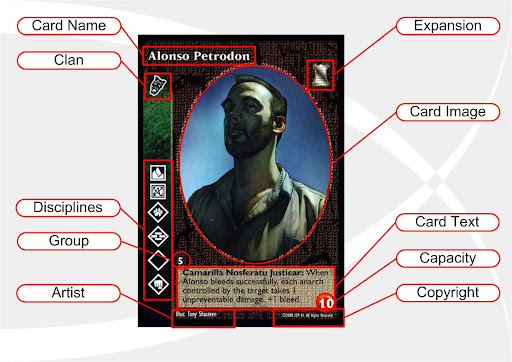
The only limitation, when building your crypt of 12 (or more) vampires, is that they must be of two adjacent groups: like, G1-G2, G2-G3, and so on up to the current grouping (G6-G7 as of the writing of this article). And no, it doesn’t come round: you can’t use G7 with G1. A few vampires, indicated ANY, are compatible with any and all grouping.
That limitation allows for a vast variety of crypts, and depending on which clan/disciplines – or specific vampires – you want to use, you’ll decide which grouping you’ll go for.
Some crypt cards were misprinted, either in their original set or in reprints, and some were changed later:
- Al-Ashrad has +1 bleed. Al-Ashrad can now burn locations requiring any clan (not only Camarilla clans).
- Alvaro, The Scion of Angelica: Gaining blood is now optional.
- Antoinette DuChamp is Group 2 and has a Capacity of 1.
- Antonio Delgado: Unlocking is now optional.
- Brachah has superior Presence and no Potence (the CE version is misprinted).
- Blythe Candelaria should have inferior Auspex.
- Camille Devereux and Raven are now fused into one: Camille Devereux, The Raven.
- Donatello Giovanni: Choosing a vampire is now optional.
- Hector Sosa should have superior Potence.
- Imogen is 9-Cap
- Lambach (ADV): Unlocking is now optional.
- Paolo Sardenzo: Gaining blood is now optional.
- Qadir ul-Ghani: The clan he changes to must be another clan than the clan to which he currently belongs.
- Radu Bistri: Gaining blood is now optional.
- Saqqaf, Keeper of the Grand Temple of Set: Gaining a pool is now optional.
- Sutekh, The Dark God: Gaining a pool is now optional, but works with all mummy allies (not only bane mummies).
- Szechenyi Jolán, Mother of Horrors: Unlocking her is now optional and happens during the discard phase.
- Ur-Shulgi has +1 bleed. The Tajdid that is retrieved from the library is now revealed.
- Vasiliy Vasilevich: Unlocking is now optional.
- Wamukota: Now explicitly locks the blocking minion.
A few vampires were banned because their names were deemed offensive to some communities. New, identical vampires were issued with different names:
- Tarbaby Jack was banned and replaced by Len Konopka.
- Tsigane was banned and replaced by Ashlesha.
b) Library cards
You can play all the library cards that were ever printed, except a very small list of banned cards. Be weary, though, that many cards have been errated and don’t exactly do what they used to (you can still use the old cards, but if in doubt check the updated card text on VDB).
The banned cards, to this day, are:
- Anthelios, The Red Star (Promo)
- Dramatic Upheaval (V:TES)
- Edge Explosion (NoR)
- Kindred Restructure (V:TES)
- Lilith’s Blessing (Promo)
- Madness of the Bard (Dark Sovereigns)
- Memories of Mortality (Ancient Hearts)
- Protect Thine Own (Ancient Hearts)
- The Return to Innocence (Ancient Hearts)
- Seeds of Corruption (Ancient Hearts)
- Succubus Club (V:TES)
- Temptation of Greater Power (V:TES)
- Cunctator Motion (V:TES)
- High Stakes (V:TES)
- Playing for Keeps (Dark Sovereigns)
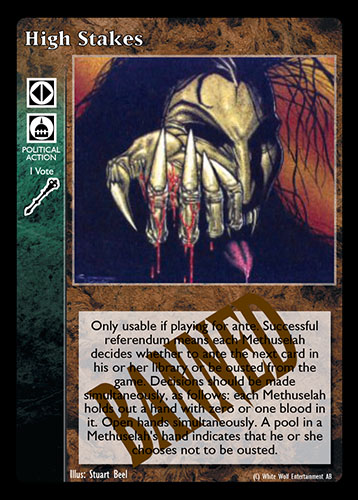
In parenthesis is the initial expansion in which they were released, but some of those cards may be present in other expansions. You will find the full detail and abbreviations of those expansions on the V:TES Wikipedia page.
Also note that Jyhad isn’t mentionned above, as it was replaced by its reprint with a more acceptable (if not palatable) name, V:TES.
Those cards are banned in all official tournaments, and I wouldn’t recommend playing them in casual games, as they have proven to be unbalancing for the game.
As with the crypt cards, a few library cards were banned and replaced because of their names:
- Gypsies (V:TES) was banned, and was replaced by an improved and cheaper Double Deuce.
- Rom Gypsy (Dark Sovereigns) was banned and replaced by its exact equivalent, City Star taxi.
- Terrorists (Ancient Hearts) was banned and replaced by a less strong but more polyvalent Dark Web Procurer.
Many card texts have been updated, for clarity or to fit small rules changes. But some of them have been drastically altered, either for balance, to fit ulterior releases, or to correct misprints. I’ll mention here the major changes, the ones that could in my opinion really affect a game. The full list of rulings and erratas can be found here (and on the following pages).
- Al’s Army Apparatus (Jyhad, VTES CE, KoT): Must be used during Minion Phase.
- Academic Hunting Ground (VTES, Jyhad, CE, KoT): Gives blood during Untap Phase.
- Amam the Devourer (FN): Followers of Set Gaining life when burning a minion in combat is now optional.
- Ambrosius, The Ferryman (AH, FN): Pathos counters are now removed during the unlock phase.
- Anarch Revolt (Jyhad, VTES, CE, Anarch, KWM, 3rd): Players with Anarch vampires do not have to pay the pool cost.
- Anarch Troublemaker (Jyhad VTES, CE, Anarch, KoT): Must be used during Untap Phase
- Archon (Jyhad, CE, KMW): Must choose a Camarilla vampire.
- Army of Apparitions (LotN): The action now fails instead of being ended.
- Army of Rats (Jyhad VTES, SW, FN, CE, Anarch, LoB): Multiples don’t stack.
- Asylum Hunting Ground (VTES, Jyhad, CE, KoT): Costs 2 pool.
- Black Metamorphosis (Sabbat, SW): is now a +1 stealth action.
- Blood Fury (Jyhad, VTES, CE, BH, KMW): Hand strike +1 rather than strike for 2.
- Blood Hunt (Jyhad, VTES, CE, KoT): May not target an Inner Circle Member.
- Blood Rage (Jyhad, VTES ,CE, 3rd): Requires Thaumaturgy. Hand Strike rather than strike for 1.
- Camarilla Exemplary (Jyhad, VTES, CE) Must choose a Camarilla vampire.
- Canopic Jar (FN): Now burns 1 life if the attached minion is an ally.
- Change of Target (Jyhad, VTES CE, Anarch, LoB, KoT): The blocker is not untapped, but rather “not tapped”
- Concealed Weapon (Jyhad CE, BH, KMW, LotN, KoT): Does not require Obfuscate.
- Consignment to Duat (BH, KMW): Now a +1 stealth action.
- Derange (Sabbat, CE, 3rd): Requires Malkavian or Malkavian Antitribu. Significant text change.
- Delaying Tactics (Jyhad, VTES, CE, 3rd, KoT, V5): Costs a blood.
- Divine Image (LotN): Now costs 1 blood instead of 2.
- Edge Vitiation (FN): Now costs no blood, instead of 1.
- Elder Impersonation (Sabbat, FN, CE, BH, KMW, 3rd): The failed blocker is not untapped, but rather “not tapped”
- Elysium: the Arboretum (Jyhad, VTES, CE, KoT) May only be used in combats between two Camarilla vampires.
- Fame (Jyhad, VTES, SW, CE, Anarchs, BH, KMW, 3rd, KoT, HttB): The controller of the targeted vampire pays 3 pool, not that player’s prey.
- Fifth Tradition: Hospitality (Jyhad, VTES, CE, KoT): Only adds 4 blood onto another vampire.
- Form of Corruption (AH, FN, KMW, LotN, 25th): Adding a counter is now optional.
- Gangrel Atavism (VTES, Jyhad): Does not require a ready Gangrel.
- Giuseppe, Gravedigger (DS, FN): Now costs no blood, instead of 1.
- Hawg (Jyhad, VTES, SW, CE): Provides an optional press each combat.
- Heaven’s Gate (LoB): Now leaves the ally in play, but removes it from combat.
- Horrid Reality (DS, FN) Equips the first weapon, not equipment.
- Jar the Soul (DS, FN): Now burns 1 life from the minion if it is an ally.
- Kali’s Fang (Ah, FN): Now costs 2 pool instead of 3.
- Majesty (Jyhad, VTES CE, Anarchs, LoB, LotN, KoT): Costs a blood at inferior and superior levels.
- Malkavian Dementia (VTES, Jyhad): Does not require a ready Malkavian.
- Malkavian Prank (VTES, Jyhad, CE, KoT): Each other Methuselah…
- Masquer (FN): Now costs 1 blood instead of 2.
- Mind Rape (Sabbat, SW, KoT): Significant text changes.
- Misdirection (Jyhad, VTES, SW, FN, CE, LoB): Costs 1 pool, taps 1 minion.
- Monocle of Clarity (Jyhad, CE, KoT): only questions pertaining to the game can be asked.
- Nightmare Curse (BL, LotN): Is burned if the acting vampire is no longer ready.
- Obedience (Jyhad, VTES, S, SW, CE, 3rd, HttB): Does not untap the reacting vampire, just don’t tap.
- Parity Shift (Jyhad, VTES, CE, 25th,V5): several significant changes.
- Pentex(TM) Subversion (DS, FN, 3rd, 25th, V5): the targeted minion can now act, not block.
- Powerbase: Washington, D.C. (Jyhad, VTES, CE): You may move 2 blood from this card to your pool each turn, not 1.
- Principia Discordia (Gehenna): The target vampire does not require to be locked.
- Pulled Fangs (Jyhad, VTES, SW, CE, Anarchs): Damage inflicted isn’t aggravated.
- Quickness (Sabbat, SW, 3rd, FN): Is free instead of costing a blood.
- Realm of the Black Sun, The (AH, FN): Now costs no pool, instead of 1. Gaining pool is now optional.
- Reform Body (Sabbat, SW): Useable by a tapped vampire.
- Revelation of Despair (KMW, LotN): Works when blocking any minion, not only one controlled by the predator.
- Second Tradition: Domain (Jyhad, VTES, CE, KMW, KoT): Significant text changes.
- Sensory Deprivation (DS, FN) Is burned if the acting vampire is no longer ready.
- Shadow Parasite (FN): Now costs 1 blood instead of 2.
- Shadowed Eyes (HttB): Burning the card costs 1 blood or life, no longer a conviction.
- Slaughtering the Herd (Sabbat SW, BH, 3rd): Requires Dominate, not Potence
- Soul Gem of Etrius (VTES, Jyhad, CE, 3rd, KoT): Does not cost 2 pool.
- Soul Stealing (DS, FN): Significant text changes.
- Summon the Abyss (Sabbat): Now costs 2 blood instead of 3.
- Summon the Serpent (AH, FN): Now a +1 stealth action.
- Tragic Love Affair (VTES, Jyhad): Does not require a ready Toreador.
- Ventrue Justicar (Jyhad, VTES, CE, KoT): Title is Ventrue (not Tremere) Justicar.
- Villein (Kot, HttB): Minion Tap cards cost you an additional pool (rather than for all players); you must move from 2 to 5 blood.
- Wake with Evening’s Freshness (Jyhad, VTES, SW, FN, CE, Anarchs, BH, KMW, LoB, HttB): Do not replace until your next untap phase (rather than after combat).
- Weeping Stone (BH): Gaining a blood is now optional.
- Wooden Stake (Jyhad, VTES, SW, CE, BH, 3rd, KoT): Significant text changes.
So, as you can see, although many cards have had their text altered over the (many) years of the game, most are still usable in any games. If you begin the game with old cards, make sure to play the cards with their current text!
2) Which cards should I get?
This is, of course, a very complex question: it depends on your individual tastes, style of play, and many other factors. You’ll find several articles (including upcoming ones) on this blog, to try to help with that question.
But right now we’ll try to see which are the best ways to get going, fast and well!
a) V5 Preconstructed decks
V5 is the current version of Vampire, the Masquerade roleplaying game. The card game follows suit, and all the currently issued decks have to fit the V5 state of affairs (clans, sects, disciplines etc).
The ideal starting product right now is the V5 Box Camarilla Edition: for the price of 4 decks, you’ll get 5, plus complete rules and tokens.
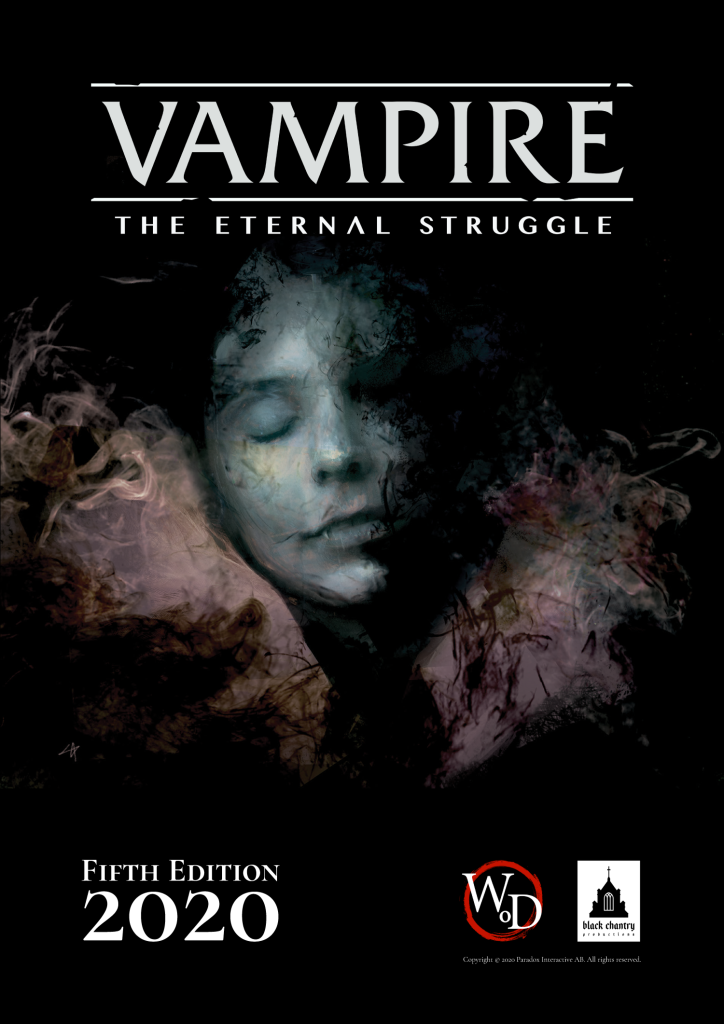
The included decks are built for clans Malkavian, Nosferatu, Toreador, Tremere and Ventrue. They are playable as such, and you can make one or two of them really competitive by mixing them a bit, printing a few proxies and/or adding cards from the New Blood introductory decks. We’re giving specific advice on that subject here.
You can, of course, buy each of those decks separately if you want to go for a specific one, while the bow will be ideal for a group of new players or a player really wanting to get a bunch of good cards.
The other V5 decks currently available are the Camarilla Banu Haqim, and the Anarch Brujah, Gangrel and Ministry. each of these decks is actually pretty great, although the Banu, Brujah and gangrel will probably require you to print some proxies for full optimisation.
The Fall of London mini-set expands the crypt and library cards, but isn’t playable in and by itself. You can read our full review of it. I wouldn’t recommended it for beginners, but once you have all the V5 starters you might want to have a look, if only to use it in the proposed Storyteller format.
b) BCP Legacy decks
Before the V5 came out, Black Chantry Productions issued a few packs that are now considered “Legacy”.
Each of the 5 preconstructed decks is honestly excellent, very competitive and contains a ton of cards that were very rare when the game came in random boosters.
We already covered them in details. They included the sabbat clans Lasombra, Toreador Antitribu, Tremere Antitribu, Tzimisce, and the very strong deck built around the Gangrel Inner Circle: Stanislava.
There are also some bundles:

- Anthology 1 includes 39 vampires (groups 4 to 6) and 50 very sought-after library cards, that cover many disciplines, clans and sects. It is a great product, but one that I’d recommend for players who already have the basics of the game straight, and have all the core cards already.
- The Keepers of Tradition bundles reprint cards from the set of the same name. Set one contains 87 vampires of the clans Brujah, Gangrel, Malkavian, and Nosferatu of the groups 4 and 5, and 33 library cards corresponding to that clans or usable by anyone. Set two covers the Caitiff, Toreador, Tremere and Ventrue. Those bundles include some staple vampires and library cards, and are great additions if you enjoy playing Camarilla and already have the V5 precos.
- The Heirs to the Blood 1 and 2 reprints, and the original Lost Kindred set, are dedicated to the various Bloodlines. They are all pretty good products, but none of them are enough to play any of the concerned clans. Worse: you’ll have trouble finding many of the cards that would complete them. BCP has announced that many of those will be found soon for print-on-demand, but as of now this isn’t the case so, as much as I love some of these bloodlines and appreciate what Lost Kindred brought to the game, I certainly wouldn’t recommend them to beginning players.
- Last but not least, three sets were available during a Kickstarter, and can now only be obtained directly from Black Chantry’s online shop. They are the Sabbat-oriented Danse Macabre, the Anarchs Unbound bundle, and the independent sets The Unaligned 1 (Assamite, Gangrel and Ravnos) and 2 (Giovanni, Followers of set and, err, more Gangrel…). As for the Bloodlines, those only complement already existing collections, but Danse Macabre will be compatible with the Lasombra deck, the Gangrel can go nicely with Stanislava, while the independent clans will rather complete print-on-demand orders (see below). Of course, those were made in small quantities, and are already starting to make themselves scarce (pun intended).
c) Print-on-demand
All the clans whose disciplines have disappeared with V5 are now available for print-on-demand on Drive-Thru cards (be careful to follow that link, and not go to the fan-made cards, which aren’t legal for play; all the official BCP cards are at 0.35$ each).
This covers the vampires and clan cards of clans: Assamite, Giovanni, Followers of Set, Lasombra, Pander, Ravnos, Salubri and Tzimisce, and also the disciplines Chimestry, Necromancy, Obeah, Obtenebration, Quietus, Serpentis and Vicissitude. You’ll also find a few cards that mention those clans and disciplines in their card-texts, and are therefore not V5-compliant.
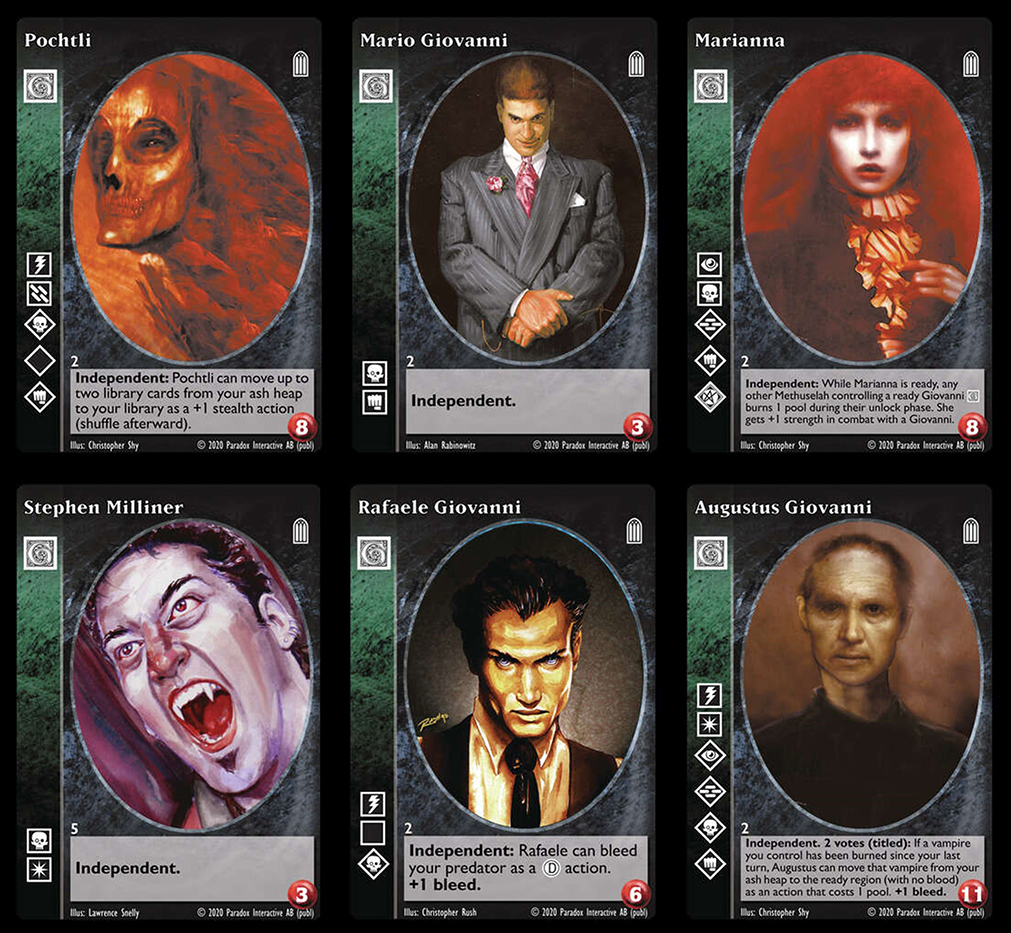
Of course, to play those clans you’ll also need the classical cards of more common disciplines like Dominate, Obfuscate or Fortitude, and perhaps a few cards printed later (like those in the corresponding Unaligned sets).
I cannot discourage you if you want to play those clans, especially Lasombra (the clan I begin VTES with) or Giovanni (hands down the best clan in the whole universe, no contest). Those “exotic” disciplines can be fun to play, each with its own very unique tricks. Just be aware that this isn’t the easiest path, and will require you to complete those cards with many others. Also, if you don’t live in the US, beware: the postage fees can be very high, so make sure to factor that into your calculations and if possible group your orders with some friends.
d) Buying used cards
Even when it was a CCG, VTES cards have never been really expensive compared to other games, and few cards went up to more than 20 bucks on the secondary market. Now that most major cards have been reprinted in fixed packs, buying individual cards or bundles should be affordable for all. You’ll find links to online shops here.
Most vampires will go for a mere 50 cts, some going up a bit, while library cards can range from a few cents to a few bucks.
A great way to get off to a good start is, of course, to buy the cards of an old player who makes the mistake to stop (or who, like me, just had waaaay too many cards and needed some space to breathe and some extra cash).
When buying a bundle, you usually shouldn’t pay as much as for individual cards. For a standard collection, including some core cards, some Rare ones as well as some total wallpaper, a good bulk price would be 10cts for a card in good conditions, rounded down a bit if the seller is nice. Don’t expect too many Dreams of the Sphynx or Powerbase: Montreal at that price, the seller will probably already have sold them separately, but there should still be some stuff of value. If you have no idea of the contents of the bulk, it should probably be priced at less.

The more sets – and preferably recent ones – are covered in the collection, the more interesting it will be for you: Jyhad/VTES library cards were good but the layout was just atrocious, and many have been errated or reprinted since; you’ll mostly be looking for vampires from those sets. Ancient Hearts/Dark Sovereigns were typical of the horrible Wizards of the Coast era and contain some overpowered cards (especially the first Inner Circle vampires) as well as the poor independent clans who got a whole ton of wallpaper, and were luckily boosted drastically in Final Nights. Sabbat had some good things, the best of which were reprinted in Sabbat War, with some good additions. Everything from Sabbat War onwards contains some pretty good vampires and interesting cards – except Nights of Reckoning of course, but who likes Imbued anyway?
The expansions usually have a theme, or are centered around a specific sect/set of clans (Camarilla, Sabbat, Independents, Anarchs, Bloodlines). Of course, they often contain cards that can be useful for all sects (for instance, discipline cards, or on the contrary cards with no requirement).
Ideally, a friend who knows the game and the value of the cards will help you determine if the lot is worth what is asked. If that’s not possible, well, you’ll be taking a gamble. But the guidelines above should help you get good cards at a correct price.
In Conclusion
As you see, there are many ways to go, although some paths are easier than some others.
Also remember that you can, as of now, build a deck with properly-printed color proxies (backed with other cards of similar format, in opaque sleeves), and play them in all tournaments except the Championships and Grand Prix! You can print them with VDB (create deck and click “PDF Proxy”) or Amaranth (create a deck, select “print some” and check “use old cards”): a great way to try out a deck before investing in the game or a specific deck.
But we all know how more pleasurable it is to own and play real cards, so hopefully this little guide will help you build fast and at a reasonable price the VTES collection of your dreams!
That’s all folks, but make sure to watch out for future beginner-oriented articles! And If you like our blog, please consider supporting the site!
Orpheus
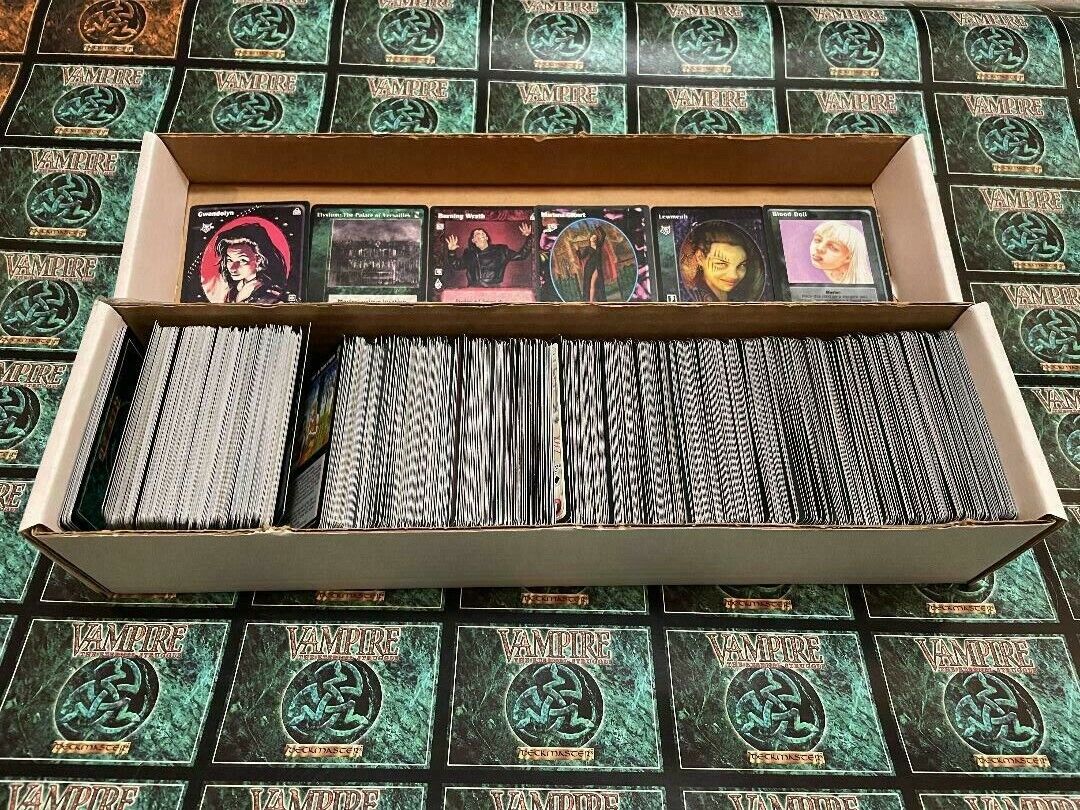

Leave a comment